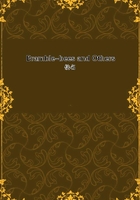
第54章 THE LEAF-CUTTERS.(3)
I am struck with another detail in the barricade. Its constituents are taken from stout, thick, strong-veined leaves. I recognize young vine-leaves, pale-coloured and velvety; the leaves of the whitish rock-rose (Cistus albidus), lined with a hairy felt; those of the holm-oak, selected among the young and bristly ones; those of the hawthorn, smooth but tough; those of the cultivated reed, the only one of the Monocotyledones exploited, as far as I know, by the Megachiles. In the construction of cells, on the other hand, I see smooth leaves predominating, notably those of the wild briar and of the common acacia, the robinia. It would appear, therefore, that the insect distinguishes between two kinds of materials, without being an absolute purist and sternly excluding any sort of blending. The very much indented leaves, whose projections can be completely removed with a dexterous snip of the scissors, generally furnish the various layers of the barricade; the little robinia-leaves, with their fine texture and their unbroken edges, are better suited to the more delicate work of the cells.
A rampart at the back of the Earth-worm's shaft is a wise precaution and the Leaf-cutter deserves all credit for it; only it is a pity for the Megachiles' reputation that this protective barrier often protects nothing at all. Here we see, under a new guise, that aberration of instinct of which I gave some examples in an earlier chapter. My notes contain memoranda of various galleries crammed with pieces of leaves right up to the orifice, which is on a level with the ground, and entirely devoid of cells, even of an unfinished one.
These were ridiculous fortifications, of no use whatever; and yet the Bee treated the matter with the utmost seriousness and took infinite pains over her futile task. One of these uselessly barricaded galleries furnished me with some hundred pieces of leaves arranged like a stack of wafers; another gave me as many as a hundred and fifty. For the defence of a tenanted nest, two dozen and even fewer are ample. Then what was the object of the Leaf-cutter's ridiculous pile?
I wish I could believe that, seeing that the place was dangerous, she made her heap bigger so that the rampart might be in proportion to the danger. Then, perhaps, at the moment of starting on the cells, she disappeared, the victim of an accident, blown out of her course by a gust of wind. But this line of defence is not admissible in the Megachile's case. The proof is palpable: the galleries aforesaid are barricaded up to the level of the ground; there is no room, absolutely none, to lodge even a single egg. What was her object, Iask again, when she persisted in obstinately piling up her wafers?
Has she really an object?
I do not hesitate to say no. And my answer is based upon what the Osmiae taught me. I have described above how the Three-horned Osmia, towards the end of her life, when her ovaries are depleted, expends on useless operations such energy as remains to her. Born a worker, she is bored by the inactivity of retirement; her leisure requires an occupation. Having nothing better to do, she sets up partitions; she divides a tunnel into cells that will remain empty; she closes with a thick plug reeds containing nothing. Thus is the modicum of strength of her decline exhausted in vain labours. The other Builder-bees behave likewise. I see Anthidia laboriously provide numerous bales of cotton to stop galleries wherein never an egg was laid; I see Mason-bees build and then religiously close cells that will remain unvictualled and uncolonized.
The long and useless barricades then belong to the last hours of the Megachile's life, when the eggs are all laid; the mother, whose ovaries are exhausted, persists in building. Her instinct is to cut out and heap up pieces of leaves; obeying this impulse, she cuts out and heaps up even when the supreme reason for this labour ceases. The eggs are no longer there, but some strength remains; and that strength is expended as the safety of the species demanded in the beginning. The wheels of action go on turning in the absence of the motives for action; they continue their movement as though by a sort of acquired velocity. What clearer proof can we hope to find of the unconsciousness of the animal stimulated by instinct?
Let us return to the Leaf-cutter's work under normal conditions.
Immediately after a protective barrier comes the row of cells, which vary considerably in number, like those of the Osmia in her reed.
Strings of about a dozen are rare; the most frequent consist of five or six. No less subject to variation is the number of pieces joined to make a cell: pieces of two kinds, some, the oval ones, forming the honey-pot; others, the round ones, serving as a lid. I count, on an average, eight to ten pieces of the first kind. Though all cut on the pattern of an ellipse, they are not equal in dimensions and come under two categories. The larger, outside ones are each of them almost a third of the circumference and overlap one another slightly.
Their lower end bends into a concave curve to form the bottom of the bag. Those inside, which are considerably smaller, increase the thickness of the sides and fill up the gaps left by the first.
The Leaf-cutter therefore is able to use her scissors according to the task before her: first, the large pieces, which help the work forward, but leave empty spaces; next, the small pieces, which fit into the defective portions. The bottom of the cell particularly comes in for after-touches. As the natural curve of the larger pieces is not enough to provide a cup without cracks in it, the Bee does not fail to improve the work with two or three small oval pieces applied to the imperfect joins.